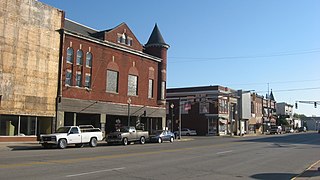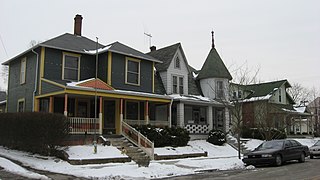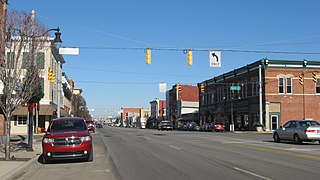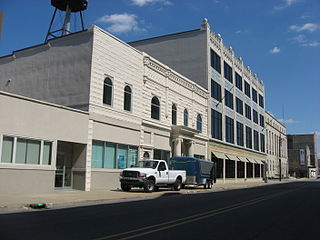
Fletcher Place is a historic district and neighborhood in the city of Indianapolis, Indiana named after Calvin Fletcher, a prominent local banker, farmer and state senator.

The Knightstown Historic District is national historic district located at Knightstown, Henry County, Indiana. It is roughly bounded by Morgan, Adams, Third, and McCullum Streets and encompasses 536 contributing buildings. It developed between about the 1830s and 1936, and includes many excellent examples of Italianate, Greek Revival, and Gothic Revival styles of architecture. Notable sites of interest include the Knightstown Academy, Elias Hinshaw House, the Knightstown Public Square. Other notable buildings include the Friends Church (1874-1875), Bethel Presbyterian Church (1885), Christian Church (1882), IOOF Building (1897-1898), Masonic Hall (1900-1901), Lehmanowsky House, Morgan Building (1866-1867), Old Town Hall (1892), Knightstown Public Library (1912), and U.S. Post Office (1936).

Daniel Craycraft House is a historic home located at Noblesville, Hamilton County, Indiana. It was built in 1892, and is a large 2 1/2-story, Queen Anne style frame dwelling. It features a three-story, square corner tower; cross-gables; steep gable-on-hip roof; porches and balconies; and contrasting textures and materials.

Dr. Samuel Harrell House, also known as the Harrell House, is a historic home located at Noblesville, Hamilton County, Indiana. It was built in 1898, and is a large 2 1/2-story, Queen Anne style frame dwelling. It features irregular massing; a three-story, polygonal corner tower; multi gable-on-hip roof; and wraparound porch. Also on the property is a contributing two-story, frame carriage house.

Noblesville Commercial Historic District is a national historic district located at Noblesville, Hamilton County, Indiana. It encompasses 54 contributing buildings in the central business district of Noblesville. It developed between about 1875 and 1931, and includes notable examples of Gothic Revival, Italianate, and Renaissance Revival style architecture. Located in the district is the separately listed Hamilton County Courthouse Square, which includes the courthouse (1877-1879) and Sheriff's Residence and Jail (1875). Other notable buildings include the Indiana Union Traction Company Station (1906), Lacy Block (1888), Evers Block (1889), U.S. Post Office (1906), U.S. Post Office (1931), and First Christian Church (1897-1898).

Catherine Street Historic District, also known as the North 9th St. Historic District, is a national historic district located at Noblesville, Hamilton County, Indiana. It encompasses 50 contributing buildings and 1 contributing site in a predominantly residential section of Noblesville. It developed between about 1870 and 1937, and includes notable examples of Queen Anne, Italianate, and Bungalow / American Craftsman style architecture. Located in the district is the separately listed Dr. Samuel Harrell House.

Hamilton County Courthouse Square is a historic courthouse and jail located at Noblesville, Hamilton County, Indiana. The jail was built in 1875–1876, and is a Second Empire style brick and limestone building. It consists of the two-story, ell-shaped jailer's residence, with a cellblock attached at the rear. It features a three-story square tower that once had a mansard roof. The courthouse was built between 1877 and 1879, and is a three-story, Second Empire style, rectangular brick building. It has a clock tower atop the mansard roof and limestone Corinthian order pilasters.

Conner Street Historic District is a national historic district located at Noblesville, Hamilton County, Indiana. It encompasses 146 contributing buildings in a predominantly residential section of Noblesville. It developed between about 1840 and 1947, and includes notable examples of Queen Anne, Italianate, Colonial Revival, Classical Revival, and Bungalow / American Craftsman style architecture. Located in the district are the separately listed William Houston Craig House and Daniel Craycraft House. Other notable buildings include the Heylmann House, Gaeth House, Wild House, Noblesville High School Gymnasium, First Presbyterian Church, and Charles Swain House.

Danville Main Street Historic District is a national historic district located at Danville, Hendricks County, Indiana. The district encompasses 37 contributing buildings in a residential section of Danville. The district developed between about 1844 and 1920 and includes notable examples of Greek Revival, Gothic Revival, Italianate, Queen Anne, American Foursquare, and Bungalow / American Craftsman style architecture. Notable buildings include the Harry Underwood House (1914), J.W. Morgan House (1868), John Shirley House (1885), and the Scearce House (1910).

Drover Town Historic District is a national historic district located at Huntington, Huntington County, Indiana. The district includes 231 contributing buildings, 2 contributing structures, and 1 contributing object in a predominantly residential section of Huntington. It developed between about 1857 and 1930 and includes notable examples of Federal, Greek Revival, Gothic Revival, Italianate, and Queen Anne style architecture. Located in the district are the separately listed German Reformed Church, Samuel Purviance House, and William Street School. Other notable buildings include the William Drover House, John Rhoads House (1896), and Griffiths Block (1896).

Portland Commercial Historic District is a national historic district located at Portland, Jay County, Indiana. It encompasses 58 contributing buildings, 1 contributing structure, and 1 contributing object in the central business district of Portland. The district developed between about 1870 and 1945, and includes notable examples of Italianate, Romanesque Revival, Classical Revival, and Early Commercial style architecture. Located in the district is the separately listed Jay County Courthouse. Other notable contributing resources include the U.S. Post Office (1914) designed by the Office of the Supervising Architect under Oscar Wenderoth, Portland Fire Station #1 (1929), Citizens Bank, FOE Eagles Lodge (1883), Johnson Building, Stevens Building (1910), Walnut Street Church of Christ (1913), and South Meridian Street Bridge (1914).

State Street Commercial Historic District is a national historic district located at Hammond, Lake County, Indiana. The district encompasses 28 contributing buildings in the central business district of Hammond. It developed between about 1885 and 1946, and includes notable example of Commercial, Classical Revival, Late Gothic Revival, and Art Deco style architecture. Notable buildings include the L. Fish Building (1927), Federal Building (1939), Lincoln Hotel (1923), Seifer Building (1925), and the Henderson Building (1902).

North Washington Street Historic District is a national historic district located in the city of Bloomington of Monroe County, Indiana. The district encompasses 35 contributing buildings and 6 contributing structures in a predominantly residential section of Bloomington. It developed between roughly 1870 and 1929, and includes notable examples of Queen Anne, Classical Revival, and Bungalow/American Craftsman style architecture. Located in the district is the separately listed Morgan House. Other notable buildings include the Showers-Graham House, Showers-Myers House, Teter House, and Washington Terrace Apartments (1929).

East Washington Street Historic District is a national historic district located at South Bend, St. Joseph County, Indiana. It encompasses 71 contributing buildings and 1 contributing structure in a predominantly residential section of South Bend. It developed between about 1880 and 1947, and includes notable examples of Italianate, Colonial Revival, American Foursquare, and Bungalow / American Craftsman style architecture and works by architects Austin & Shambleau. Notable buildings include the James and Marie Zimmerman House (1921), Eger House (1911), George and Emma Hewitt House (1905), Ruth and Edwin H. Sommerer House (1930), Chauncey T. Fassett House (1898), Dougdale Carriage Barn (1900), and Sunnyside Presbyterian Church.

South Michigan Street Historic District is a national historic district located at South Bend, St. Joseph County, Indiana. It encompasses nine contributing buildings on a commercial strip in South Bend. It developed between about 1911 and 1945, and includes notable examples of Classical Revival style architecture. The buildings are primarily two-story, brick commercial buildings, some with stone or terra cotta trim. They include the former Smith-Alsop Paint Store Building (1922), Myer-Seeberger Building (1916), Whitmer-McNeese Building (1928), and LaSalle Paper Company Building (1925).

Highland Park Neighborhood Historic District is a national historic district located at Lafayette, Tippecanoe County, Indiana. The district encompasses 240 contributing buildings, 1 contributing site, and 1 contributing structure in a planned residential subdivision of Lafayette. It developed between about 1892 and 1945 and includes representative examples of Queen Anne, Tudor Revival, and Bungalow / American Craftsman style architecture. Notable contributing resources include the Blistain Axel Merritt House (1914), John Wagner Jr. House, John Ross House, and Bicycle Bridge (1924).

Park Mary Historic District is a national historic district located at Lafayette, Tippecanoe County, Indiana. The district encompasses 106 contributing buildings and 1 contributing structure in a predominantly residential section of Lafayette. It developed between about 1853 and 1950 and includes representative examples of Italianate, Queen Anne, and Bungalow / American Craftsman style architecture. Notable contributing buildings include the Thomas Hull House (1870), Fry House (1873), Perrin House (1868), Fletmeyer House (1881), Keipner House (1885), Behm House (1858), Greagor House (1873), Ulrick House, John and William Levering House (1858), Sawyer House (1868), Lafayette Christian Reformed Church (1929), Lincoln School (1923), and Lafayette Armory (1927).

North Meridian Street Historic District is a national historic district located at Indianapolis, Indiana. It encompasses 169 contributing buildings in a high style residential section of Indianapolis. The district developed between about 1900 and 1936, and includes representative examples of Tudor Revival, Colonial Revival, and Classical Revival style architecture. Located in the district is the separately listed William N. Thompson House. Other notable contributing resources include the Evan-Blankenbaker House (1901), Sears-Townsend House (1930), MacGill-Wemmer House, Hugh Love House (1930), Hare-Tarkington House (1911), Shea House (1922), and Brant-Weinhardt House (1932).

Washington Street–Monument Circle Historic District is a national historic district located at Indianapolis, Indiana. The district encompasses 40 contributing buildings and 2 contributing structures in the central business district of Indianapolis centered on Monument Circle. It developed between about 1852 and 1946, and includes representative examples of Italianate, Greek Revival, and Art Deco style architecture. Eighteen of the contributing buildings are individually listed on the National Register of Historic Places. Other notable buildings include the L.S. Ayres & Co. Department Store, Kahn Tailoring Company Building (1915), Hannaman and Duzan Building (1852), Odd Fellows Building (1907–1908), Hotel Harrison (1927–1928), Guaranty Building (1922–1923), Circle Tower (1929–1930), Consolidated Building (1909), and Turner Building and Savings Association (1941).

Shortridge–Meridian Street Apartments Historic District is a national historic district located at Indianapolis, Indiana. The district encompasses 136 contributing buildings in a predominantly residential section of Indianapolis. It was developed between about 1900 and 1951, and includes representative examples of Colonial Revival, Classical Revival, Late Gothic Revival, Mission Revival, Renaissance Revival, Bungalow / American Craftsman, and Art Deco style architecture. Located in the district is the separately listed Shortridge High School. Other notable buildings include the Vernon Court Apartments (1928), Fronenac Apartments (1951), Biltmore Apartments (1927), Meridian Apartments (1929), New Yorker Apartments (1917), Howland Manor (1929), Powell-Evans House (1911), Harms House (1906), Dorchester Apartments (1921), and Martin Manor Apartments (1916).
























